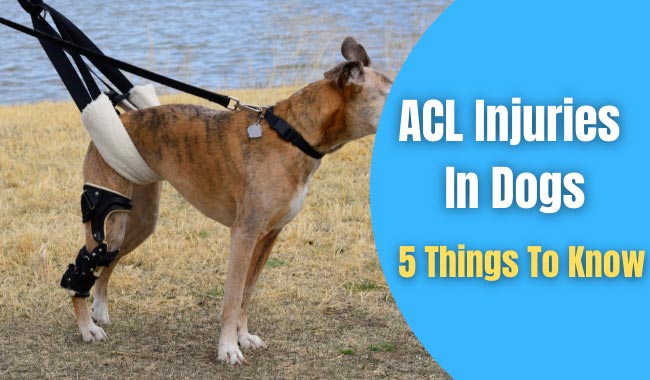
You might be familiar with the ACL (anterior cruciate ligament) injury in athletes. But what you might not know is that it can also happen to dogs. Essentially, ACL, which stands for anterior cruciate ligament, is essential in a human knee. However, unlike humans, they don’t have ACL.

Related Posts:
- Caring for a Dog after an IVDD Diagnosis
- The Average Cost of Pet Insurance: A Basic Guide
- 7 Tips for Caring for Senior Dogs
- Learn About Pet Insurance in Details
- Oklahoma Dog Law: Who Is Liable In A Dog Attack?
Instead, they have the cranial cruciate ligament (CCL), which is responsible for stabilizing their knee joints. Due to the difference in physical anatomy, a canine’s ACL is more susceptible to wear and tear injuries. When this happens, your dog will be subjected to a lot of pain and the like. Hero Brace provides the stability you need for your dog to get back to life.
To properly handle this kind of condition with dogs, below are the five things to know about ACL injury from the get-go:
1. The Signs Of An ACL Injury Are Not Always Noticeable To Pet Owners
Although ACL injury can be considered a common knee injury in dogs, it doesn’t mean the signs are always visible to the eyes of the owners. As a result, they fail to address this problem as quickly as possible. Due to this situation, it’s crucial to bring your canine to the veterinarian for a regular checkup.
With a pair of trained eyes, they can assess your pet for the following signs of ACL injury:
- Lameness or limping;
- Using one leg over the other;
- Reluctance to jump, exercise, or go on walks; and
- Joint stiffness, which is more common after exercising.
Given the veterinarian’s years of experience, they’ll perform a thorough orthopedic examination of your dog’s legs and pelvic to identify the signs and properly diagnose them with an ACL injury.
For instance, a licensed veterinarian will check your pet’s mobility performance and look at certain signs of discomfort, including an abnormal movement to the knee, which usually happens when the ACL or CCL is damaged. They’ll also examine your dog’s body for muscle loss and bone issues.
Nonetheless, if you want to understand better how veterinarians diagnose ACL injury, you can visit websites like https://www.sunnysidevetclinic.com/ and other options for more valuable information.
2. Immediate Treatment Of Your Dog’s ACL Injury Is Essential

If your dog is diagnosed with an ACL injury, it’s crucial to seek prompt treatment as quickly as possible. When left untreated, the injury will worsen over time, causing too much pain to your canine. Plus, when one leg is injured, they’ll start to overuse the other leg to prevent walking on the injured part.
Unfortunately, doing so can result in overcompensation, which can damage the healthier leg over time. When this happens, you and your dog might be in huge trouble. It means more pain, treatment, and a lengthy recovery period for your pet while expensive treatment costs for you. To avoid these consequences, make sure to get your dog treated right away after diagnosing them with an ACL injury.
3. Certain Breeds Are More At Risk For ACL Injuries
While ACL injuries are common to all canines regardless of sizes and shapes, there are certain canine lineages that have an increased risk of suffering this knee injury. In most cases, large breed canines aged four years and above are believed to be prone to be diagnosed with ACL injuries. These can include:
- Akita;
- American Staffordshire Terrier;
- Chesapeake Bay Retriever;
- Golden Retriever;
- Labrador Retriever;
- Rottweiler; and
- St. Bernard.
So, if you have any of the dog breeds mentioned above, make sure to get them checked regularly by your vet to determine their risk of ACL injury. That way, your pet dog will receive immediate treatment if they’re diagnosed with the said injury.
4. ACL Injuries Are Commonly Treated By Surgery
The typical treatment option for ACL injuries in dogs is a surgical procedure. Typically, there are various types of surgeries that can help restore stability to your dog’s knee joint. These can include:
- Extracapsular Repair: It’s performed by replacing the torn knee ligament with an artificial one. It’s recommended for dogs weighing less than 50 pounds.
- Tibial Tuberosity Advancement (TTA): It involves the cutting of the tibia and moving it forward to realign the two bones that connect the knee joint and stabilize it.
- Tibial Plateau Leveling Osteotomy (TPLO): It’s done by flattening the top portion of the tibia to stabilize it in its new position using screws and a plate. Although this surgical procedure is similar to TTA, the difference is that it doesn’t require a longer recovery time.
Typically, the different types of ACL surgeries in dogs require a substantial amount of recovery time.
Although some may need a shorter period than other types, it’s essential to note that recovery from ACL surgery can be a lengthy process. In that case, you need to focus on your dog’s healing as a pet owner. Make sure to follow all the vet’s instructions regarding the medications.
Lastly, avoid forcing your pet to do physical activities following the surgery, as they might only cause a re-injury.
5. Non-Surgical Treatment Options Are Also Available To Dogs With ACL Injury
Depending on the severity of your dog’s ACL injury, they may not require a surgical procedure. Instead, they may be qualified to use some non-surgical treatment options such as:
- Weight Loss: Since extra weight places additional pressure on your dog’s knee joints, weight loss may be necessary to treat a minor ACL injury. You can help your dog manage their weight through proper nutrition and exercise.
- Rest: It can help minimize your dog’s physical activity, which is essential in decreasing pain and slowing the deterioration of the injury.
- Pain Medications: ACL injuries can cause your pet a great deal of pain. As such, you can provide them with nonsteroidal anti-inflammatory drugs to alleviate the pain and improve their condition.
- Braces: They offer support by immobilizing your ankle and knee to ease the pain caused by the injury.
- Acupuncture: It can also be used to lower inflammation, provide stimulation to the nervous system, and facilitate effective healing.
- Laser Therapy: It’s a non-invasive procedure used for increasing blood circulation and stimulating the cell regeneration process.
- Physical Therapy: It involves rehabilitation exercises that are used to improve your dog’s use of their legs and motion.
Bottom Line
It’s painful to see your furry friend limping or screaming in pain because of an ACL injury. When it’s untreated, it can affect their quality of life in the long run. Hence, if your canine has been diagnosed with an ACL injury, keep the information provided above to know what to expect and do. Remember, the more you’re familiar with what ACL injury in dogs is, the more you can handle the situation effectively.
Author Bio
Kelly Oker works as an assistant in a veterinary clinic. They share their knowledge about dogs and other animals by writing and posting articles online. During their free time, they go hiking with friends.



